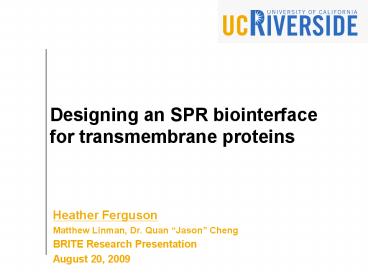Designing an SPR biointerface for transmembrane proteins - PowerPoint PPT Presentation
1 / 17
Title:
Designing an SPR biointerface for transmembrane proteins
Description:
Lack of signal between EGFR cells in lipid membrane and Erbitux may indicate ... Create an interface based on the calcinated chip (glassified layer on gold) for ... – PowerPoint PPT presentation
Number of Views:71
Avg rating:3.0/5.0
Title: Designing an SPR biointerface for transmembrane proteins
1
Designing an SPR biointerface for transmembrane
proteins
- Heather Ferguson
- Matthew Linman, Dr. Quan Jason Cheng
- BRITE Research Presentation
- August 20, 2009
2
Outline
- Background information
- SPR and EGFR
- Experimental approach
- Results
- Conclusions
- Future work
3
Background - SPR
- Metals with free electrons
- Gold, silver
- P-polarized light at resonance angle excites
electrons - Angle at which photons couple with plasmons
- Plasmons are collective vibrations of electron
gas
4
Experimental Setup for SPR
Characteristic Sensorgram (2) Association (3)
Equilibrium (4) Dissociation
Cooper, M.A. Nat. Rev. Drug Discovery 2002, 1, 517
5
Membrane Proteins
- Target of 60 of drugs
- Epidermal Growth Factor (EGFR)
- Overexpressed in epithelial cancers
- Lung, ovary, breast, colon
- 3 domains
- Intracellular tyrosine kinase
- lipophilic transmembrane
- Extracellular ligand binding
- Antibodies
- Polyclonal anti-EGFR TK
- mAb Erbitux (cetuximab)
- Provided by Eureka Therapeutics Inc.
Huang S., Invest New Drugs 1999, 259-269
6
Methods Protein Concentration Assay
- Purify cells
- Extract proteins
- Bio-Rad Protein Assay kit
- Colorimetric, similar to ELISA
- Folin reagent alkaline copper tartrate
- UV/vis spectroscopy to measure absorbance
- Use standards to make calibration curve (1.6
0.2 mg/ml) - Determined EGFR 4.06 mg/ml
7
Methods - SAM
1-Ethyl-3-3-dimethylaminopropylcarbodiimide
(EDC) N-hydroxysulfosuccinimide (Sulfo-NHS)
SH(CH2)10 COOH
- Stable bond between sulfur and gold
- Short hydrocarbon chain
- Change functional groups
Johanna Stettner, Institute of Solid State
Physics, Graz University of Technology
8
Covalent Coupling mAb to SAM
- mAb binding significantly stronger to EGFR cells
than the control
9
SAM-Based Design on Polyclonal Ab
- EGFR cells 84.3 mdeg
- Control 62.9 mdeg
- Control signal still large
10
EGFR in Tethered Bilayer Membrane
- Small signal increase after injection of
Anti-EGFR (2 µg/ml) - Co-injected PC vesicles along with cells
- EGFR cells 413 mdeg
- Control cells 352 mdeg
- Tethered membrane provides space
- Biologically relevant
11
Interface Design II Biotinylation
- Biotin-Avidin bonds
- Very strong (Ka 1015 M-1 )
- orientation specific
- Biotinylate TK antibody
- Sulfo-NHS-LC-Biotin kit
Biotin
NHS
12
Effect of Biotinylation
Biotin BSA signal 3X greater than control
13
Complete Surface System
- Biotin BSA, NeutrAvidin, biotin anti-EGFR, PC
vesicles cells (EGFR and control) - Ideally, the signal should be greater from the
EGFR cells, and Erbitux should have a greater
signal
14
Conclusions
- Biotinylation procedure is effective.
- Erbitux shows preferential binding to cells
overexpressing EGFR compared to control cells. - Current method of combining EGFR and PC vesicles
can be improved. - Lack of signal between EGFR cells in lipid
membrane and Erbitux may indicate improper
orientation within the membrane - Both SAMs and biotinylated surfaces show promise
15
Next Steps
- Determine ideal membrane interface design for
effective and functional EGFR immobilization for
protein binding. - Try different lipid mixtures to more closely
mimic natural membrane - Create an interface based on the calcinated chip
(glassified layer on gold) for direct
immobilization of the EGFR in a membrane. - Use mAb Erbitux once ideal interface design is
determined - Apply best interface design to a microarray
format for high-throughput screening with SPR
imaging.
16
Acknowledgements
- Matt Linman and Dr. Cheng
- National Science Foundation
- Jun Wang and BRITE REU program
17
References
- Hopkins, A. L. Groom, C. R. Nat.Rev. Drug
Discovery 2002, 1, 727730. - Hubbard, S. R. Cancer Cell 2005, 7, 287-288.
- Kim, Edward S., et al. Epidermal growth factor
receptor biology. Current Opinion in Oncology
2001, 13, 506-513. - Li, Shiqing et al. Cancer Cell 2005, 7, 301-311.
- Liedberg, B., I. Lundstrom, and E. Stenberg.
1993. Principles of biosensing with an extended
coupling matrix and surface plasmon resonance.
Sensors and Actuators B 11 63-72. - Linman, M. J. Culver S.P. Cheng Q. Langmuir
2009, 25, 3075-3082. - Macher, Bruce A., Yen, Ten-Yang. Proteins at
membrane surfaces a review of approaches. Mol.
Biosyst. 2007, 3, 705-713.































